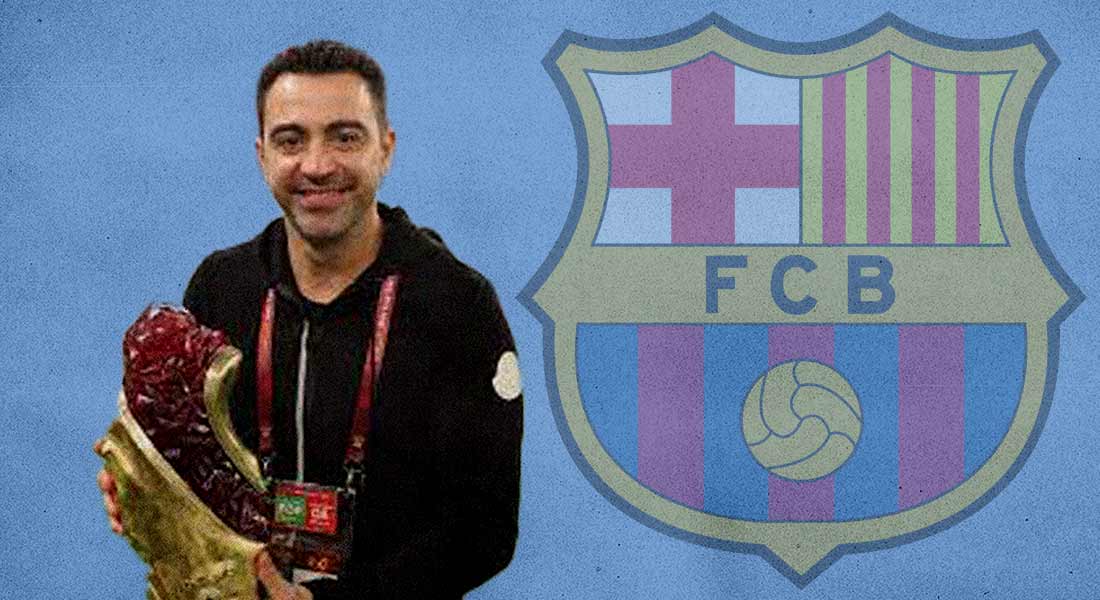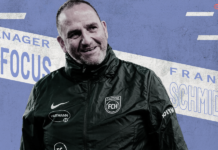The news of Xavi’s arrival as manager of Barcelona has been mostly greeted by welcoming fans. After the joyless start to the season under Ronald Koeman, the club is in dire need of someone who uplifts the mood around Camp Nou and who better to do that than a club legend. Right?
🚨 𝐈𝐓‘𝐒 𝐎𝐅𝐅𝐈𝐂𝐈𝐀𝐋! 🚨
Xavi is coming back! https://t.co/9Cf8AONfWP
— FC Barcelona (@FCBarcelona) November 6, 2021
Well…depends on what one terms as “lifting the mood.” If one is looking for a recent familiar face in the dugout who is well known by everyone, yes certainly Xavi does that. On the other hand, if the expectation is to turn Barcelona into world-class once again…that is a long journey. The club is beset with teething problems, from style of play to performances against inferior opposition and that is before the financial mess is taken into account.
Ronald Koeman believes Lionel Messi disguised all the problems at Barcelona 👀 pic.twitter.com/6zAqGIZnKE
— ESPN FC (@ESPNFC) September 24, 2021
Xavi knows that he does not have too many games at hand to get his philosophy across to the players but wait. What exactly is Xavi’s form of setting his side up, tactics used and what can actually Barcelona expect given the players they have?
POSSESSION, POSSESSION, POSSESSION
There are a few things to know before discussing the tactics employed. Xavi confesses that he wants his team to have as much of the ball as possible. That they should not be afraid of keeping it and not having possession makes him go crazy. It is what he did as a player and now translates as a manager.
أغنية سداوي لأبعد حد .. غناء عبدالعزيز لويس @Abdulazizluieshttps://t.co/tnqp2ZgSJL#دائما_مع_السد pic.twitter.com/J5TgvrFlSz
— 🏆 #76 Al Sadd SC | نادي السد (@AlsaddSC) October 22, 2021
So it is no surprise that Al-Sadd dominate games with over 60% of the ball on average. How that is aided other than tactics will be seen later but for now, let’s get back to the setup.
3-2-4-1 and 3-4-3 are the two most common systems used by Xavi. However, the flexibility that he allows his team helps in switching between the two during matches as well. The two midfielders operating as the pivot are one of the most vital elements to the whole exercise.
Xavi has Al Sadd playing beautiful football 👏 pic.twitter.com/xVRMwCyeuJ
— ESPN FC (@ESPNFC) October 28, 2021
Jung Woo-young is the defensive enforcer who helps in breaking up passes and assisting the backline while Guilherme is a supreme passer of the ball who can also carry it upfield. That enables the whole team to push forward together and given the fact Xavi keeps his wingers extremely wide, there are a lot of avenues to move the ball into.
Turki Al-Ali: The #AlSadd administration has agreed on Xavi’s move to Barcelona after the payment of the release clause stipulated in the contract. We’ve agreed on cooperation with Barcelona in the future. Xavi is an important part of Al-Sadd’s history and we wish him success. pic.twitter.com/3FvCOdYl5X
— 🏆 #76 Al Sadd SC | نادي السد (@AlsaddSC) November 5, 2021
The system of “tiki-taka” is highly prevalent with Al-Sadd, who can be found stringing together a whole bunch of passes in their buildup. Xavi stresses on the importance of the ‘free man’ and ‘numerical superiority.’ In the former, there should always be one-two players in space to receive the ball and even play it forward. Santi Cazorla, operating in the number 9 role, drops into midfield to get the ball and then turn in the opposite direction which starts attacks. Though the whole process is time consuming, it helps the team that their opponents are happy to sit back in a low block to defend most of the time.
ATTACK MORE, GET THE BALL
Creating an overload in attack, with Xavi emphasizing on playing in the opponent’s half as much as possible, Al-Sadd always looks to put pressure. The five forward players stay in and around the penalty area while the wingers look to cut inside at most opportunities. The central striker Baghdad Bounedjah remains an aerial threat too while the others can shoot whenever getting a good look at goal.
🏆⚽️QNB STARS LEAGUE 2021-22
⚽️GOAL 49'
Umm Salal SC 1-3 Al Sadd SC
Scorer: André Ayew#QNBstarsLeague #qsl #alsaddsc #ummsalalsc @QSL_EN @QSL @AyewAndre pic.twitter.com/DkevQTKRWP— Alkass Digital (@alkass_digital) October 26, 2021
Xavi had stated that opponents defend against Al-Sadd mostly as a back five so he looks to create superiority in numbers. If the attack goes down the side, the central midfielders get closer and vice versa. A lot of it is based on carrying the ball and drawing the defenders out of their position which helps in setting up free spaces. Given the domination of the ball by Al-Sadd, they are able to do this easily which explains their high rate of scoring.
Xavi has now won 7 trophies in two years as Al Sadd manager 🏆 pic.twitter.com/ZfzjoVQu26
— ESPN FC (@ESPNFC) October 25, 2021
When they lose the ball or the opponent has it from a set-piece, Xavi has been categorical in winning the ‘second ball.’ They want to regain possession as quickly as possible and preferably inside their opponent’s half or close to it. So that they can be on the front foot again and one-two defenders are stationed near the centre line to stop the quicker counter attacks.
𝑀𝑖𝑠𝑡𝑒𝑟 X6VI pic.twitter.com/r7Z4Y4fB0L
— FC Barcelona (@FCBarcelona) November 6, 2021
The whole team comes down to defend as a unit in their specific lines, leaving one or two players up for the quick transition. This clearly demonstrates the extremely high workrate of his players who know their specific roles and are always on the move.
HOW CAN BARCELONA DO IT?
Coming to Xavi’s future (former?) club and what they can achieve with the pieces they have. If Xavi persists with the 3-2-4-1, there are possibilities in every position regarding the players he can play. Ronald Araujo is a lock-in for one of the back three but who are the two to go alongside him? Oscar Mingueza or Eric Garcia can operate as the right-sided centre back but the left one is a trickier affair.
📊| Ronald Araújo vs Granada.
• 1 Goal.
• 81 Touches.
• 64/68 Passes.
• 5 Shots.
• 1 Dribble Completed.
• 11/13 Duels Won. (Most)
• 2 Clearances.
• 10/12 Aerials Won.
• 1 Interception.
• 5 Ball Recoveries.
• 0 Fouls.
• 0 Times Dribbled Past.What. A. Performance. 🔥 pic.twitter.com/zBbi2yR69J
— Barça Buzz (@Barca_Buzz) September 20, 2021
Both Clement Lenglet and Samuel Umtiti have not had the adequate amount of game time yet to get up to match speed. Gerard Pique’s running days are long over and Xavi’s system depends on fast players who are extremely mobile.
The midfield two are pretty much settled with Sergio Busquets being the defensive one while Frenkie de Jong orchestrates attacks. Despite Busquets’ fallible nature in recent times, there are no viable alternatives for the Blaugrana to consider. The five above these two are where the real juggling acts will begin.
Infographic: Frenkie De Jong's stats vs Valladolid.
– 93/98 passes completed
– 5 duels won
– 4 recoveries pic.twitter.com/lPFq4yImbO— Barça Universal (@BarcaUniversal) April 5, 2021
Barcelona’s scoring struggles have been quite evident this season, some part of it due to the fact that Memphis Depay has been playing on the left side of a front three. That is in sharp contrast to his central role with the Netherlands national team where he scores almost regularly. If Xavi persists with Depay out wide, one of Ousmane Dembele or Ansu Fati can man the other side.
Xavi plans to use Ansu Fati and Ousmane Dembélé in very wide positions. He considers that the wings have been underutilized in the last few years.
— @gerardromero pic.twitter.com/d0qXz61v3q
— Barça Universal (@BarcaUniversal) October 28, 2021
Philipe Coutinho can play as the false nine while Pedri will be alongside him in a slightly deeper role so as to act as the linchpin between midfield and attack. Sergio Aguero is of course the main striker up front.
The role of traditional fullbacks is harder to incorporate in Xavi’s system which can mean leaving Jordi Alba and Sergino Dest out. The form of Dest, in particular, has been particularly useful getting forward though his shooting leaves a lot to be desired. Dest and Dembele will have a right old fight over the right-wing slot while the return of Martin Braithwaite might finally free up Depay to play through the middle too.
Aguero's first Barcelona goal comes in El Clasico 👏 pic.twitter.com/ukIl22s434
— ESPN FC (@ESPNFC) October 24, 2021
However, that would mean benching Aguero and it remains to be seen what Xavi does about that. Nevertheless, one of the key differences between Al-Sadd and Barcelona right now is not only about the Catalans’ own personnel but something more.
THE LEVEL OF COMPETITION
Addressing the elephant in the room, Al-Sadd are the most dominant side in Qatar who have been winning trophies ever since Xavi took over. They have some of the best players who play for the national team and even their foreign players have a bevvy of international experience. Moreover, the fact that they score such a high number of goals really speaks to the quality of their opposition rather than their own attacking prowess.
🇩🇿 Baghdad Bounedjah all-time stats in the Qatar Stars League:
👕 104 appearances
⏱️ 8700 minutes
⚽️ 121 goals
🎯 35 assists
📊 1.61 Goals + Assists per 90 minutesPhenomenal. pic.twitter.com/tWdBtgG0m4
— DZfoot English 🇩🇿⚽️ (@DZfoot_EN) October 1, 2021
In a recent match against Al-Gharafa, Xavi’s side conceded four and scored six. These are not the kind of score lines one can expect in La Liga. A more worrying trend is how easily Al-Sadd have been outwitted in the AFC Champions League when they came up against much tougher opponents. The round-of-16 is the best that they have managed but without their possession-based game and moving quickly upfield, the plan gets muddier.
🇶🇦 Al-Sadd league record under Xavi since the start of last season
▶️ Played – 29
👍 Won – 26
🤝 Drawn – 3
👎 Lost – 0
⚽️ Goals – 106 (3.7 per game)👑 The natural heir to the throne at Camp Nou? pic.twitter.com/KAEaYgL2Sw
— WhoScored.com (@WhoScored) October 28, 2021
La Liga will definitely not be the journey Xavi has witnessed so far and given how much Barcelona’s overall quality has fallen in recent years, there will not be too much of a surprise if the turnaround takes some good amount of time. Even the middling teams can topple the mighty giants on their day while the race to the title will be tougher than ever.
Barcelona's away record this season:
🏟️ Games: 5
✅ Wins: 0
🤝 Draws: 2
❌ Losses: 3
⚽ Goals: 1
🥅 Conceded: 7 pic.twitter.com/Y4dIPAXBQ0— Football Tweet ⚽ (@Football__Tweet) October 27, 2021
The Champions League will be another ballgame and as Barcelona have already struggled so mightily in the group stages, what happens in the knockout rounds if they do qualify remains open to imagination. Barcelona can finally get back on their feet but Xavi knows the work is not going to be easy.




